May 30, 2025 | 14:33 GMT +7
May 30, 2025 | 14:33 GMT +7
Hotline: 0913.378.918
May 30, 2025 | 14:33 GMT +7
Hotline: 0913.378.918

An staff of the Northern Mountainous Agriculture & Forestry Science Institute (left) providing instructions on cultivation techniques for new tea varieties in Long Coc commune. Photo: Trung Quan.
The new tea varieties created by the Northern Mountainous Agriculture & Forestry Science Institute (NOMAFSI) must be accompanied by a special cultivation process as well as suitable soil and climatatic conditions in order to fully promote their unique advantages.
Areas with an altitude of below 500 meters are suitable for tea varieties that produce black tea and green tea for export such as LDP1, LDP2, PH1, PH8, PH11, etc. Certain soils and climates are suitable for the cultvation of specialty tea varieties such as Kim Tuyen, Phuc Van Tien, Huong Bac Son, VN15, LCT1, etc.
Areas with an altitude of over 500m is suitable for tea varieties that can adapt to the cold climate and produce specialty tea such as native shan tea, Chat Tien shan, LP18, PH8, PH12, PH14, etc.
Long Coc commune in Tan Son district, Phu Tho province features an unique topography with multiple rows of hills. The Long Coc tea brand has has firmly established its position on the market.
According to Mr. Ha Van Luong, Vice Chairman of Long Coc Communal People's Committee, the only crops grown on local hills in the past were acacia, cassava, corn, and potatoes, which had a minimal economic impact. The Middleland tea was initially planted in a handful of households within the province, and it eventually covered the entire hillside.
The tea trees were gradually separated with inconsistent qualities because farmers propagated their own tea from the seeds. The tea fields were populated with tea trees of varying colors, strengths and heights that are difficult to maintain. The relatively inexperience care techniques have negatively impacted the yield and quality of tea, resulting in fluctuating selling prices. Several households who have escaped from poverty with the help of tea trees are at risk of falling back into poverty. Some farmers have even considered replacing their tea trees.
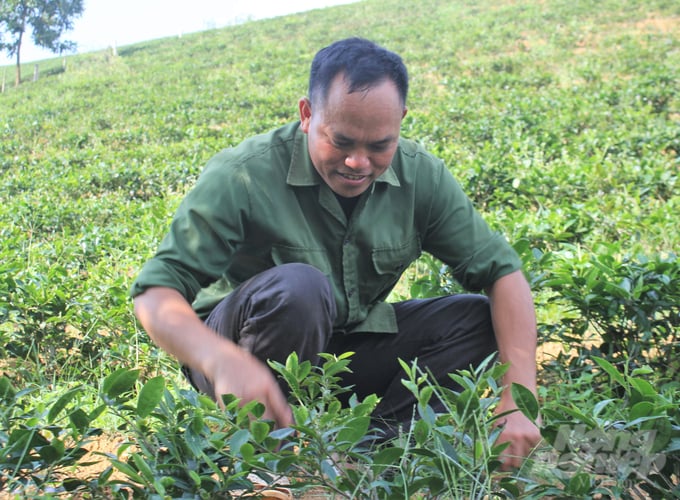
Mr. Ha Van Nui, a tea farmer from Mang 1 hamlet, Long Coc commune, is excited because the new tea varieties have higher yield and quality compared to the former midland tea varieties. Photo: Hoang Anh.
In response to these challenges, NOMAFSI has provided the commune with new, high-yield, high-quality tea varieties such as PH8, PH9, etc. for trial cultivation. Additionally, the Institute has transfered the techniques to local farmers in order to revive the green color of tea trees. Accordingly, NOMAFSI has brough high quality tea varieties and specialty teas such as LDP1, LDP2, PH8, Huong Bac Son, TRI5.0, VN15, LCT1, etc. to Long Coc commune.
From small production areas, the new tea varieties quickly spread and gradually replaced the former midland tea varieties. Long Coc commune currently has nearly 800 hectares of new tea varieties, including 700 hectares in harvest with an average yield of 13 to 14 tons per hectare. Conversely, the former midland tea varities only yielded an average of 5 to 7 tons per hectare.
The new tea varieties boast outstanding qualities that are sought after by many traders throughout the country. As a result, the local people's incomes and lives have gradually improved. The percentage of impoverished households in the commune decreased over the years. The average annual income in the commune has reached 32 million VND per person.
Long Coc commune is planning to grow quality tea varieties and form a large raw material area for processing factories; establish VietGAP-compliant tea production areas, promote organic production in association with the development of specialty products, experience tourism and so on.
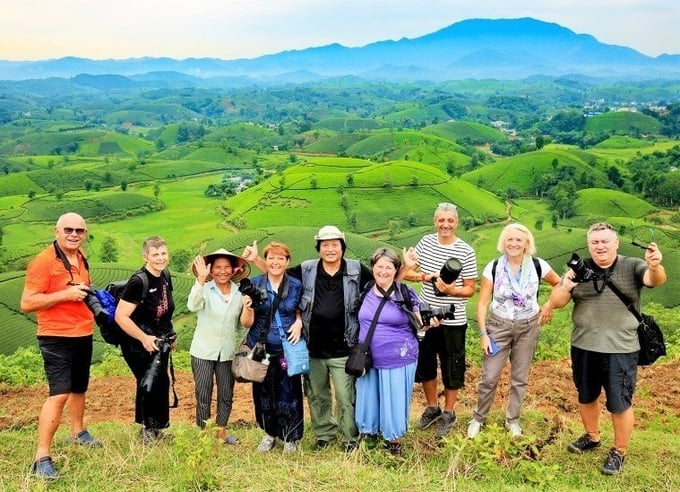
The tea production area in Long Coc commune has attracted a sizeable number of tourists. Photo: HA.
Mr. Ha Van Nui from Mang 1 hamlet, Long Coc commune is a pioneer in the experimental cultivation of new tea varieties provided by NOMAFSI. He established a production team with six other households in order to share their experience in growing new tea varieties on an area of 12 hectares.
According to Mr. Nui, the farmers of Long Coc commune had to travel to Van Mieu commune in Thanh Son district, Phu Tho province to ask for small quantities of tea seeds. The tea trees are grown without appropriate care techniques from the farmers. When the new tea varieties were brought to the commune, accompanied by detailed instructions and technical training from the Institute's staff, local farmers began strategically planning for the tea trees.
Mr. Nui briefly talked about the characteristics and planting techniques of a tea variety with the knowledge of an expert: the PH8 tea variety has multiple low brances with strong growth, early sprouting window, flaky bulbs, high yield at an early stage, suitability for intensive farming, adaptability, drought and cold tolerance, resistance to pests and diseases among many other traits. This tea variety can be grown in double rows, with a density between 2 and 2.2 thousand trees per hectare. The trees must be cut and shaped early. After reaching one year of age, farmers are recommended to proceed with the first stage of cutting and shaping; the second stage should be conducted between the age of two and three.
"My family grows 1.3 hectares of tea. We harvest nearly 30 tons of fresh tea every year. After deducting expenses, we earn between 80 and 100 million VND annually", Mr. Nui shared.
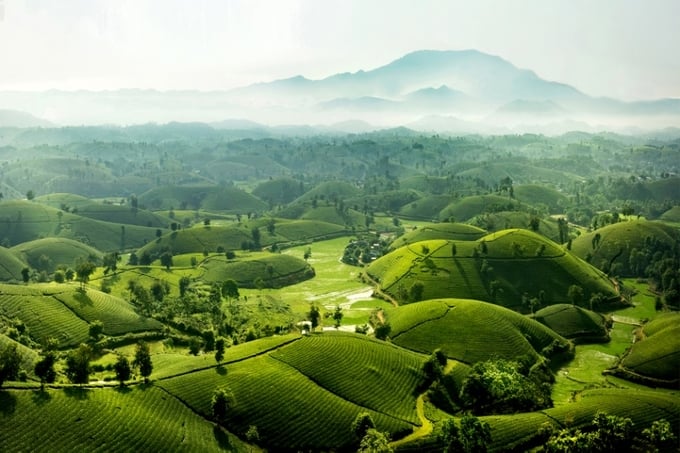
The beautiful landscape of Long Coc tea production area.
With numerous beautiful, organic, and VietGAP-compliant tea farms, Long Coc commune has the potential to combine agricultural tourism activities with specialty tea products. Each tea farmer in Long Coc commune can act as a tour guide to introduce about the locally produced tea, affirming the quality of Long Coc's tea on the international market.
Mr. Nguyen Van Thanh, Director of Da Hen Tea Production and Processing Cooperative in Da Hen Tea Production and Processing Craft Village, Dong Luong commune, Cam Khe district, Phu Tho province shared: "Our products are created from new varieties so we insist that every visitor have a taste of our special tea".
Mr. Thanh recalled the story of his village: "Tea trees were first introduced to our village in 2001. However, the majority of farmers were hesitant to cultivate them. This is because they have the tradition of growing eucalyptus. On the other hand, the prices of tea at the time were falling rapidly and many households had to replace their tea trees, so farmers were wary of the risks. However, according to approximation at the time, 1 hectare of eucalyptus took between six and seven years to be ready for harvest. After deducting costs, eucalyptus will have only made a profit of approximately 10 million VND.
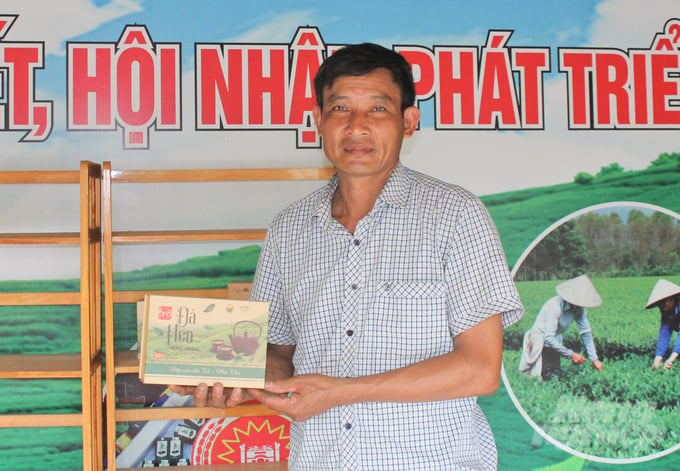
Mr. Nguyen Van Thanh, Director of Da Hen Tea Production and Processing Cooperative. Photo: Trung Quan.
Despite the challenges, Mr. Thanh and several households who had faith in tea trees have made an effort in learning about the cultivation, caring, processing and consumtion of tea. Subsequently, the Da Hen Tea Production and Processing Craft Village was established in 2010. Members of the craft village cooperated to purchase machinery and raw tea for processing.
After acknowledging that the income of tea production is secured and significantly higher compared to that of eucalyptus, the remaining households gradually converted to tea production over the years. The number of members of the Craft Village increased rapidly, with 80 concurrent households. The total tea production area skyrocketed to over 100 hectares. From an overlooked crop, the tea tree has become a staple in the local agricultural production, creating employment opportunities and improving the lives of Da Hen residents.
The new LCT1 tea variety created by NOMAFSI was brought to Da Hen in 2013 for trial production. High quality tea varieties such as LDP1, LDP2, Huong Bac Son, Bat Tien, VN15, etc. quickly followed suit. New tea varieties quickly asserted their advantages in terms of yield and quality compared to that of the traditional midland tea varieties.
With its reputation quickly established, the high quality Da Hen tea is sought after by tea companies across the country. Tea raw materials are immediately consumed upon production. Many households have invested in machinery, established tea production and processing association for export companies. Da Hen village swiftly transformed into one of the busiest tea production, processing and consumption sites in Phu Tho province.
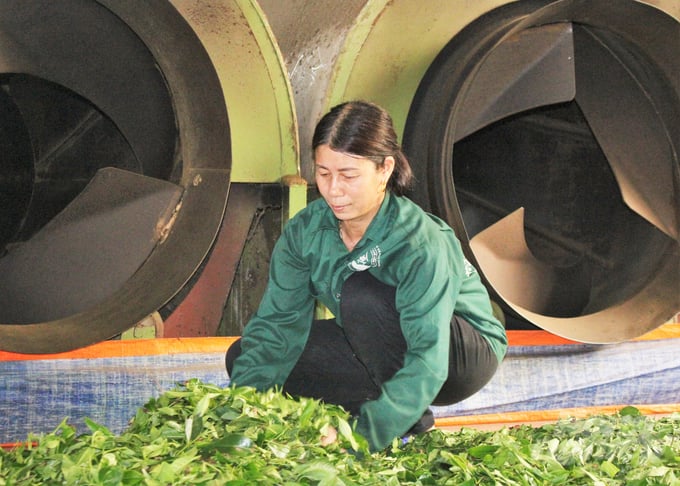
The new batch of tea varieties have elevated the Da Hen tea brand. Photo: Trung Quan.
Da Hen craft village provides an average of 500 to 600 tons of tea to the market every year. The average selling price of tea ranges from 35,000 to 40,000 VND per kilogram. Additionally, finished tea products are sold at an average of 60,000 VND per kilogram. After deducting costs, tea farmers can expect a stable annual income between 50 and 60 million VND per hectare. Most notably, deep tea processing households can earn up to 100 million VND per hectare every year.
Translated by Nguyen Hai Long
/2025/05/25/4127-3-073637_820.jpg)
(VAN) Thanks to the promotion from an FAO-implemented project, vegetable production in greenhouses in Moc Chau has seen strong development, from 1.5 hectares in 2021 to nearly 50 hectares in 2024.

(VAN) FAO has recently supported USD 140,000 to implement the project 'Risk mitigation human-animal interface risks through disease control initiatives in pig farming.'

(VAN) The People's Committee of Tra Vinh province has approved an adjustment to the investment policy for the Green Hydrogen Plant project, increasing its area to approximately 52.76 hectares.
![Reducing emissions from rice fields: [2] Farmers’ commitment to the soil](https://t.ex-cdn.com/nongnghiepmoitruong.vn/608w/files/news/2025/05/05/dsc08881jpg-nongnghiep-140632.jpg)
(VAN) Clean rice cultivation model in Thuong Tan commune, Bac Tan Uyen district, is assisting local residents in achieving sustainable agriculture by substantially reducing costs, increasing productivity, and protecting the environment.

(VAN) At the conference to disseminate Resolution No. 68, AgriS introduced its digital agricultural ecosystem and reaffirmed its commitment to accompanying the Government in promoting private sector development and sustainable agriculture.

(VAN) 'Blue Ocean - Blue Foods' initiative is designed to restore marine ecosystems and establish sustainable livelihoods for local communities by cultivating a minimum of 1,000 hectares of cottonii seaweed in the first three years.
/2025/05/21/4642-3-112707_603.jpg)
(VAN) The V-SCOPE project has made direct contributions to three out of six pillars of the Comprehensive Strategic Partnership between Vietnam and Australia.